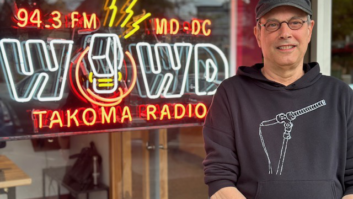
IBiquity claims it has achieved “critical mass” in the auto aftermarket receiver category this week, with the news of JVC and Jensen mobile tuners on the market that do iTunes Tagging.
On first glance, that would seem to be quite a boast.
They’re saying HD Radio technology is growing market share in both high- and mid-range brands, as Alpine, JVC, Kenwood, Pioneer, Sony, Clarion, Dual and Jensen increase their adoption of the technology.
I was skeptical, so I checked out the 2010 Buyer’s Guide iBiquity hands out at shows. It lists 23 items in the aftermarket category that are available now: eight in-dash units, nine tuner boxes and nine in-dash/tuner bundles. So certainly by category it’s the largest, compared to 13 docking systems, 14 tabletops, three portables (Insignia HD, Zune HD and the two Gigaware iPod accessories,) and the 10 Hi-Fi systems and their associated 11 tuners.
But that’s out of, say, a bazillion total radios in aftermarket auto.
What the numbers don’t show is how the manufacturers’ progression unfolds, and this is what I think iBiquity means.
Remember that in 2004, Kenwood sold the first HD Radio receiver on the market, an aftermarket unit. Yamaha unit debuted a high-end home unit in July 2005; that December, Alpine introduced its first aftermarket product, and Boston Acoustics debuted the first HD Radio tabletop. At the time, the tabletop was eagerly anticipated by GMs who wanted to be able to demo their digital sound to advertisers without lugging around a car radio that had been “retrofitted” into a box for carrying purposes.
Like automakers, receiver manufacturers incorporate new technology into their product lines on their timetable — not that of the radio industry. Some receiver manufacturers jump into new technology right away, offering an “initial” or “add-on” version, while others wait to more fully incorporate it into their product lines, after first seeing how it does in the marketplace. Manufacturers each have their own timelines for accomplishing these tasks.
Sony, for example, waited until this year to ship its first aftermarket CD receiver with built-in HD Radio (as opposed to a box that needs a separate IBOC tuner to work with select head-units). Others, like Sherwood, are only now offering their first HD Radio, this year, which happens to be an audio/video unit.
So, back to “critical mass” — which, to me, means a tipping point where manufacturers feel they need to include IBOC in their product lines to be competitive. The phrase is likely to be met with hoots of laughter by those who feel HD Radio has been a flop; those critics are out there, and they remain vocal. And certainly iBiquity, like other companies, has been known to use breathless marketing phrases in its releases. But this one seems different. I don’t think Jeff Jury would use that phrase without giving it some careful thought first.
Certainly there’s steady progress. When I first began attending CES, you could count the manufacturers offering HD Radios on one hand. Now it takes me longer to get to all of those booths. Aftermarket auto was the first category to carry HD Radio products in meaningful numbers.
So I’ll give iBiquity this one for the aftermarket category. What will be interesting to see is if the gradual progress in this category is duplicated in others, like factory in-dash or portables and how long it will take to get to those tipping points. We’ll see in time.












